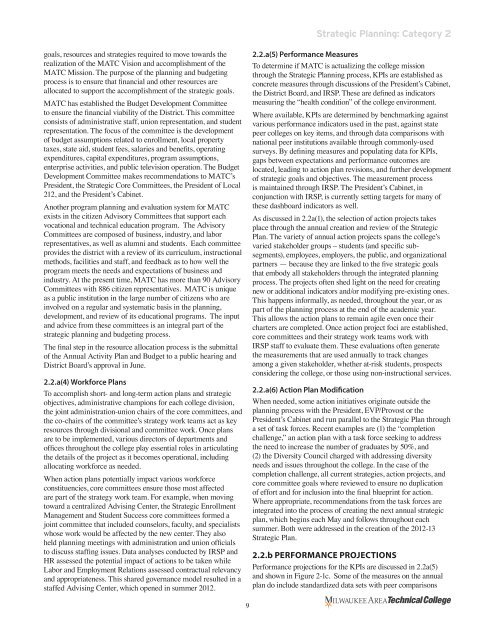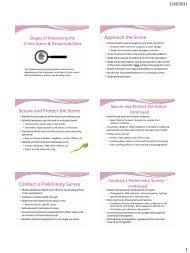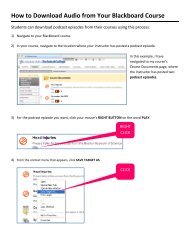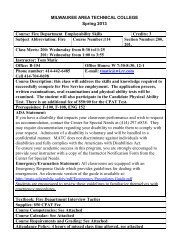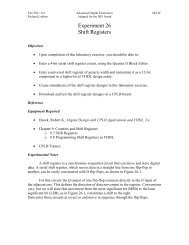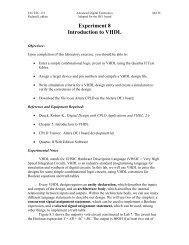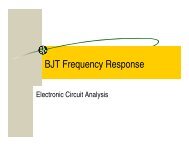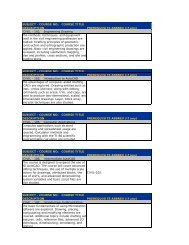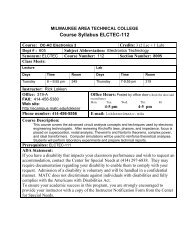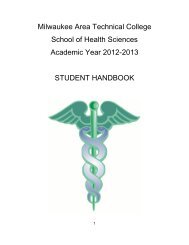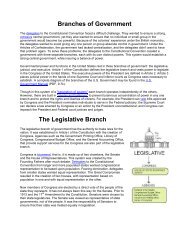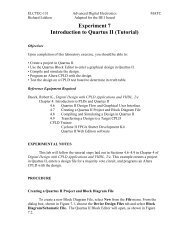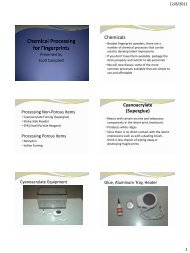WI Forward Award 2012 - Welcome to MATC - Milwaukee Area ...
WI Forward Award 2012 - Welcome to MATC - Milwaukee Area ...
WI Forward Award 2012 - Welcome to MATC - Milwaukee Area ...
You also want an ePaper? Increase the reach of your titles
YUMPU automatically turns print PDFs into web optimized ePapers that Google loves.
Strategic Planning: Category 2<br />
goals, resources and strategies required <strong>to</strong> move <strong>to</strong>wards the<br />
realization of the <strong>MATC</strong> Vision and accomplishment of the<br />
<strong>MATC</strong> Mission. The purpose of the planning and budgeting<br />
process is <strong>to</strong> ensure that financial and other resources are<br />
allocated <strong>to</strong> support the accomplishment of the strategic goals.<br />
<strong>MATC</strong> has established the Budget Development Committee<br />
<strong>to</strong> ensure the financial viability of the District. This committee<br />
consists of administrative staff, union representation, and student<br />
representation. The focus of the committee is the development<br />
of budget assumptions related <strong>to</strong> enrollment, local property<br />
taxes, state aid, student fees, salaries and benefits, operating<br />
expenditures, capital expenditures, program assumptions,<br />
enterprise activities, and public television operation. The Budget<br />
Development Committee makes recommendations <strong>to</strong> <strong>MATC</strong>’s<br />
President, the Strategic Core Committees, the President of Local<br />
212, and the President’s Cabinet.<br />
Another program planning and evaluation system for <strong>MATC</strong><br />
exists in the citizen Advisory Committees that support each<br />
vocational and technical education program. The Advisory<br />
Committees are composed of business, industry, and labor<br />
representatives, as well as alumni and students. Each committee<br />
provides the district with a review of its curriculum, instructional<br />
methods, facilities and staff, and feedback as <strong>to</strong> how well the<br />
program meets the needs and expectations of business and<br />
industry. At the present time, <strong>MATC</strong> has more than 90 Advisory<br />
Committees with 886 citizen representatives. <strong>MATC</strong> is unique<br />
as a public institution in the large number of citizens who are<br />
involved on a regular and systematic basis in the planning,<br />
development, and review of its educational programs. The input<br />
and advice from these committees is an integral part of the<br />
strategic planning and budgeting process.<br />
The final step in the resource allocation process is the submittal<br />
of the Annual Activity Plan and Budget <strong>to</strong> a public hearing and<br />
District Board’s approval in June.<br />
2.2.a(4) Workforce Plans<br />
To accomplish short- and long-term action plans and strategic<br />
objectives, administrative champions for each college division,<br />
the joint administration-union chairs of the core committees, and<br />
the co-chairs of the committee’s strategy work teams act as key<br />
resources through divisional and committee work. Once plans<br />
are <strong>to</strong> be implemented, various direc<strong>to</strong>rs of departments and<br />
offices throughout the college play essential roles in articulating<br />
the details of the project as it becomes operational, including<br />
allocating workforce as needed.<br />
When action plans potentially impact various workforce<br />
constituencies, core committees ensure those most affected<br />
are part of the strategy work team. For example, when moving<br />
<strong>to</strong>ward a centralized Advising Center, the Strategic Enrollment<br />
Management and Student Success core committees formed a<br />
joint committee that included counselors, faculty, and specialists<br />
whose work would be affected by the new center. They also<br />
held planning meetings with administration and union officials<br />
<strong>to</strong> discuss staffing issues. Data analyses conducted by IRSP and<br />
HR assessed the potential impact of actions <strong>to</strong> be taken while<br />
Labor and Employment Relations assessed contractual relevancy<br />
and appropriateness. This shared governance model resulted in a<br />
staffed Advising Center, which opened in summer <strong>2012</strong>.<br />
2.2.a(5) Performance Measures<br />
To determine if <strong>MATC</strong> is actualizing the college mission<br />
through the Strategic Planning process, KPIs are established as<br />
concrete measures through discussions of the President’s Cabinet,<br />
the District Board, and IRSP. These are defined as indica<strong>to</strong>rs<br />
measuring the “health condition” of the college environment.<br />
Where available, KPIs are determined by benchmarking against<br />
various performance indica<strong>to</strong>rs used in the past, against state<br />
peer colleges on key items, and through data comparisons with<br />
national peer institutions available through commonly-used<br />
surveys. By defining measures and populating data for KPIs,<br />
gaps between expectations and performance outcomes are<br />
located, leading <strong>to</strong> action plan revisions, and further development<br />
of strategic goals and objectives. The measurement process<br />
is maintained through IRSP. The President’s Cabinet, in<br />
conjunction with IRSP, is currently setting targets for many of<br />
these dashboard indica<strong>to</strong>rs as well.<br />
As discussed in 2.2a(1), the selection of action projects takes<br />
place through the annual creation and review of the Strategic<br />
Plan. The variety of annual action projects spans the college’s<br />
varied stakeholder groups – students (and specific subsegments),<br />
employees, employers, the public, and organizational<br />
partners — because they are linked <strong>to</strong> the five strategic goals<br />
that embody all stakeholders through the integrated planning<br />
process. The projects often shed light on the need for creating<br />
new or additional indica<strong>to</strong>rs and/or modifying pre-existing ones.<br />
This happens informally, as needed, throughout the year, or as<br />
part of the planning process at the end of the academic year.<br />
This allows the action plans <strong>to</strong> remain agile even once their<br />
charters are completed. Once action project foci are established,<br />
core committees and their strategy work teams work with<br />
IRSP staff <strong>to</strong> evaluate them. These evaluations often generate<br />
the measurements that are used annually <strong>to</strong> track changes<br />
among a given stakeholder, whether at-risk students, prospects<br />
considering the college, or those using non-instructional services.<br />
2.2.a(6) Action Plan Modification<br />
When needed, some action initiatives originate outside the<br />
planning process with the President, EVP/Provost or the<br />
President’s Cabinet and run parallel <strong>to</strong> the Strategic Plan through<br />
a set of task forces. Recent examples are (1) the “completion<br />
challenge,” an action plan with a task force seeking <strong>to</strong> address<br />
the need <strong>to</strong> increase the number of graduates by 50%, and<br />
(2) the Diversity Council charged with addressing diversity<br />
needs and issues throughout the college. In the case of the<br />
completion challenge, all current strategies, action projects, and<br />
core committee goals where reviewed <strong>to</strong> ensure no duplication<br />
of effort and for inclusion in<strong>to</strong> the final blueprint for action.<br />
Where appropriate, recommendations from the task forces are<br />
integrated in<strong>to</strong> the process of creating the next annual strategic<br />
plan, which begins each May and follows throughout each<br />
summer. Both were addressed in the creation of the <strong>2012</strong>-13<br />
Strategic Plan.<br />
2.2.b PERFORMANCE PROJECTIONS<br />
Performance projections for the KPIs are discussed in 2.2a(5)<br />
and shown in Figure 2-1c. Some of the measures on the annual<br />
plan do include standardized data sets with peer comparisons<br />
9


